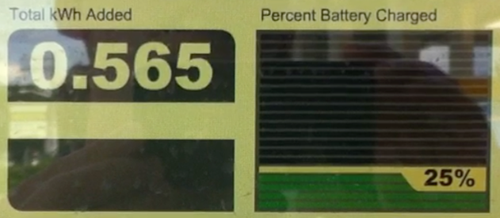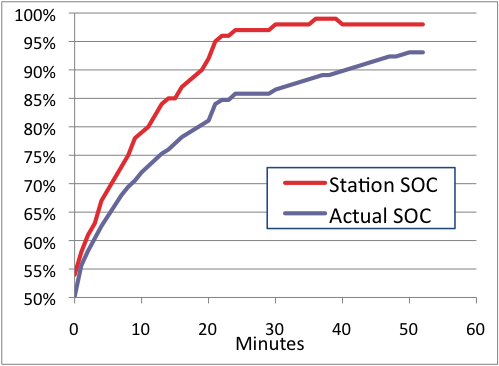I've been driving electric vehicles since 2008, logging over 50,000 miles, and have never had an experience where my vehicle's lack of engine noise created an unsafe situation. However, the issue of quiet vehicles and pedestrians is subtle and complex.
I have had a pedestrian walk backwards through the traffic lane in a parking lot while carrying on a conversation with someone across the lot. She didn't notice my vehicle, but I was watching where I was driving and going slow enough to react to her carelessness. I just stopped and waited about 30 seconds for her to see me. She of course made a rude comment blaming me for the unsafe situation she caused.
I've also had many times when driving through a parking garage where pedestrians are walking up the middle of the traffic lane, totally oblivious to my presence. However I find that happens with about the same frequency it did when I was driving gas cars, which I attribute to the echoing in concrete garages making it hard to hear slow-moving vehicles from behind, even when they are close.
I've also had the experience of being in a shopping center parking lot, hearing a car drive up behind me, and before turning around knowing it was my wife, Cathy, because I recognized the distinctive sound of a Tesla Roadster. On the flip side, Cathy has noticed not being able to hear a nearby gas car in a parking lot because of the noise made by a much louder gas car an aisle or two over.
As a responsible driver, I don't depend on pedestrians hearing the roar of my engine so they can scramble out of my way before I mow them over. But the situation is more complex than just my personal experience.
In May of 2011, I participated in a meeting of the United Nations working group that is developing a proposal for an international standard for quiet vehicles. There I learned a great deal about the subject and was able to share my insights as an experienced electric vehicle driver.
The predominant sound made by cars moving above 15 to 20 miles per hour is tire noise. At slower speeds, it's engine idling, fans, and so forth. It's those lower speeds that are of concern.
Hybrid and electric vehicles aren't the only quiet vehicles on the road. Many modern sedans are also virtually silent at low speeds where tire noise is not significant. Therefore, the UN is taking a broader approach to this problem than the US Pedestrian Safety Enhancement Act of 2010, which only considers minimum noise levels for electric and hybrid vehicles.
The sound made by gas cars is actually quite poor for alerting pedestrians to nearby vehicle traffic. Most of the sound made by internal combustion vehicles is low-frequency, which humans have difficulty locating, and carries for long distances, adding to ambient noise levels that can mask out nearby vehicles.
For an artificial car sound to be effective, it has to be localizable and distinguishable as coming from a vehicle. So having an EV rumble like a muscle car or chirp like a bird is a terrible idea. Studies presented at the UN workgroup meeting show that the best sounds are broad spectrum sounds without low frequency content.
The issue is even more complex for blind pedestrians who develop skills in using their senses in ways that are completely outside the experience of the sighted public. The idling sounds made by stationary vehicles are useful not only for detecting the presence of nearby cars, but also for using them as positional markers. Consider walking across a wide, busy street and trying to stay in the crosswalk with your eyes closed. The sound of the idling cars nearest the crosswalk act as navigational beacons, keeping blind pedestrians from drifting out of the crosswalk and into traffic. For this reason, it's important to be able to hear a car in the street even if it is not moving.
It's also important to be able to judge the size of vehicles by their sound. Drivers behind a large, stopped vehicle can get impatient at the hold-up and decide to blast around the unwanted obstruction, only to find that there was a good reason for the large vehicle to be stopped: pedestrians in a crosswalk. For this reason, blind pedestrians may choose to avoid this risk by choosing not to cross when they hear a large vehicle at the head of the line.
As an EV driver, I appreciate the quiet ride of electric cars. The last thing I want is some obnoxious artificial sound added to my car. From what I learned at the working group meeting, a properly designed sound doesn't have to be overly loud, it can be effective even at a sound level that is below the ambient noise level. I believe we can add sound to quiet cars to increase pedestrian safety without compromising the advantage of electric cars in improved driving experience and reduced noise pollution, but doing so demands careful thought and consideration of many complex issues.
I have had a pedestrian walk backwards through the traffic lane in a parking lot while carrying on a conversation with someone across the lot. She didn't notice my vehicle, but I was watching where I was driving and going slow enough to react to her carelessness. I just stopped and waited about 30 seconds for her to see me. She of course made a rude comment blaming me for the unsafe situation she caused.
I've also had many times when driving through a parking garage where pedestrians are walking up the middle of the traffic lane, totally oblivious to my presence. However I find that happens with about the same frequency it did when I was driving gas cars, which I attribute to the echoing in concrete garages making it hard to hear slow-moving vehicles from behind, even when they are close.
I've also had the experience of being in a shopping center parking lot, hearing a car drive up behind me, and before turning around knowing it was my wife, Cathy, because I recognized the distinctive sound of a Tesla Roadster. On the flip side, Cathy has noticed not being able to hear a nearby gas car in a parking lot because of the noise made by a much louder gas car an aisle or two over.
As a responsible driver, I don't depend on pedestrians hearing the roar of my engine so they can scramble out of my way before I mow them over. But the situation is more complex than just my personal experience.
In May of 2011, I participated in a meeting of the United Nations working group that is developing a proposal for an international standard for quiet vehicles. There I learned a great deal about the subject and was able to share my insights as an experienced electric vehicle driver.
The predominant sound made by cars moving above 15 to 20 miles per hour is tire noise. At slower speeds, it's engine idling, fans, and so forth. It's those lower speeds that are of concern.
Hybrid and electric vehicles aren't the only quiet vehicles on the road. Many modern sedans are also virtually silent at low speeds where tire noise is not significant. Therefore, the UN is taking a broader approach to this problem than the US Pedestrian Safety Enhancement Act of 2010, which only considers minimum noise levels for electric and hybrid vehicles.
The sound made by gas cars is actually quite poor for alerting pedestrians to nearby vehicle traffic. Most of the sound made by internal combustion vehicles is low-frequency, which humans have difficulty locating, and carries for long distances, adding to ambient noise levels that can mask out nearby vehicles.
For an artificial car sound to be effective, it has to be localizable and distinguishable as coming from a vehicle. So having an EV rumble like a muscle car or chirp like a bird is a terrible idea. Studies presented at the UN workgroup meeting show that the best sounds are broad spectrum sounds without low frequency content.
The issue is even more complex for blind pedestrians who develop skills in using their senses in ways that are completely outside the experience of the sighted public. The idling sounds made by stationary vehicles are useful not only for detecting the presence of nearby cars, but also for using them as positional markers. Consider walking across a wide, busy street and trying to stay in the crosswalk with your eyes closed. The sound of the idling cars nearest the crosswalk act as navigational beacons, keeping blind pedestrians from drifting out of the crosswalk and into traffic. For this reason, it's important to be able to hear a car in the street even if it is not moving.
It's also important to be able to judge the size of vehicles by their sound. Drivers behind a large, stopped vehicle can get impatient at the hold-up and decide to blast around the unwanted obstruction, only to find that there was a good reason for the large vehicle to be stopped: pedestrians in a crosswalk. For this reason, blind pedestrians may choose to avoid this risk by choosing not to cross when they hear a large vehicle at the head of the line.
As an EV driver, I appreciate the quiet ride of electric cars. The last thing I want is some obnoxious artificial sound added to my car. From what I learned at the working group meeting, a properly designed sound doesn't have to be overly loud, it can be effective even at a sound level that is below the ambient noise level. I believe we can add sound to quiet cars to increase pedestrian safety without compromising the advantage of electric cars in improved driving experience and reduced noise pollution, but doing so demands careful thought and consideration of many complex issues.


